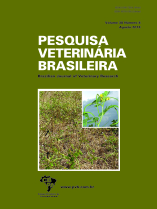 |
|
|
|
Year 2018 - Volume 38, Number 8
|

|
Testicular histological evaluation and serum testosterone concentrations of bulls after chemical castration with calcium chloride, 38(8):1554-1563
|
ABSTRACT.- Pereira L.F., Dias F.G.G., Miguel M.P., Honsho C.S., Tavares D.C., Hellú J.A.A. & Souza F.F. 2018. Testicular histological evaluation and serum testosterone concentrations of bulls after chemical castration with calcium chloride. [Avaliação histológica e das concentrações séricas de testosterona de touros após a castração química com cloreto de cálcio.] Pesquisa Veterinária Brasileira 38(8):1554-1563. Departamento de Reprodução Animal e Radiografia Veterinária, Faculdade de Medicina Veterinária e Zootecnia, Universidade Estadual Paulista “Júlio de Mesquita Filho”, Rua Prof. Dr. Walter Maurício Correa s/n, Cx. Postal 560, Campus de Botucatu, Botucatu, SP 18618‑681, Brazil. E-mail: fabiana.f.souza@unesp.br
Orchiectomized bulls have advantages in the meat quality and ease of handling. Chemical castration is an option for surgical castration and the sclerosing agents can be administered into the testicular or epididymis parenchyma. These agents have a lower incidence of complications than surgery, especially when associated with dimethylsulfoxide (DMSO), which has anti‑inflammatory action and increases the absorption of other drugs. Thus, this study aimed to evaluate the effect of a single intratesticular injection of calcium chloride solution associated with DMSO for the chemical sterilization of bulls. Twenty-four young adult bulls were utilized, distributed into 3 groups (G20, G30 and G40, n = 8/group), according to the calcium chloride concentration (20, 30 and 40%), in 10mL volume. Serum concentrations of testosterone, body weight, testicular volume and ecotexture, clinical signs and behavior and were evaluated for 45 days. Thus, the animals were orchiectomized and testicles were assessed histologically. There were no changes in body weight, decreased serum testosterone concentrations (except G30), signs of scrotal sensitivity or changes in behavior over the period. However, there was significant increase in testicular volume, especially on the 2nd and 3rd day after treatment, with values returning to the value initials at 15 days. Testicular adherence and firm consistency were observed during orchiectomy. Ultrasound examination revealed a loss of integrity of the median raphe, with cavity formation and an alteration of the testicular echotexture. In the histological evaluation, coagulation necrosis of seminiferous tubules and interstitial cells was observed, mainly in the medial portion in all groups. Some animals presented total absence of tubular formations in all the studied groups, being the effects of greater intensity in the G40. Additionally, pronounced edema was noted in all groups, especially in G40. Inflammatory infiltrate, fibroplasia and neovascularization were found to be predominantly discrete. Based on the conditions used in this study, we conclude that calcium chloride associated with DMSO can be used as a method of chemical sterilization in bovines. |
| |
|
|
| |
|
 |